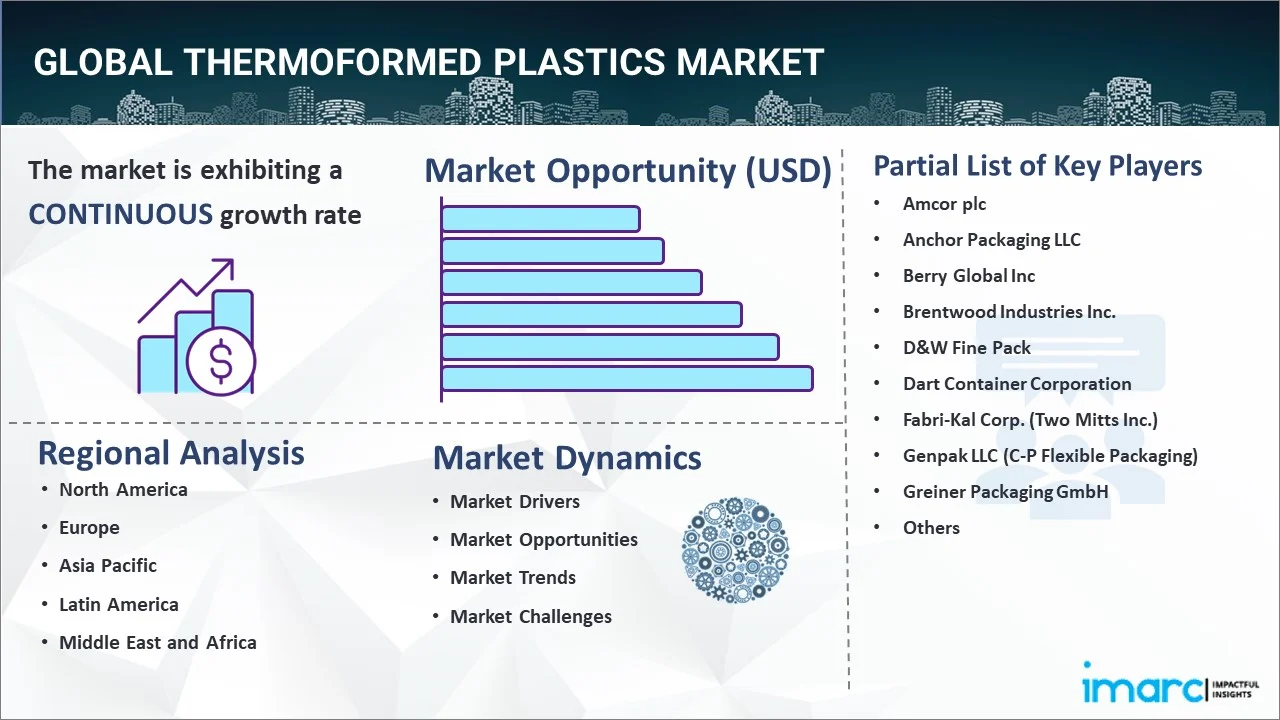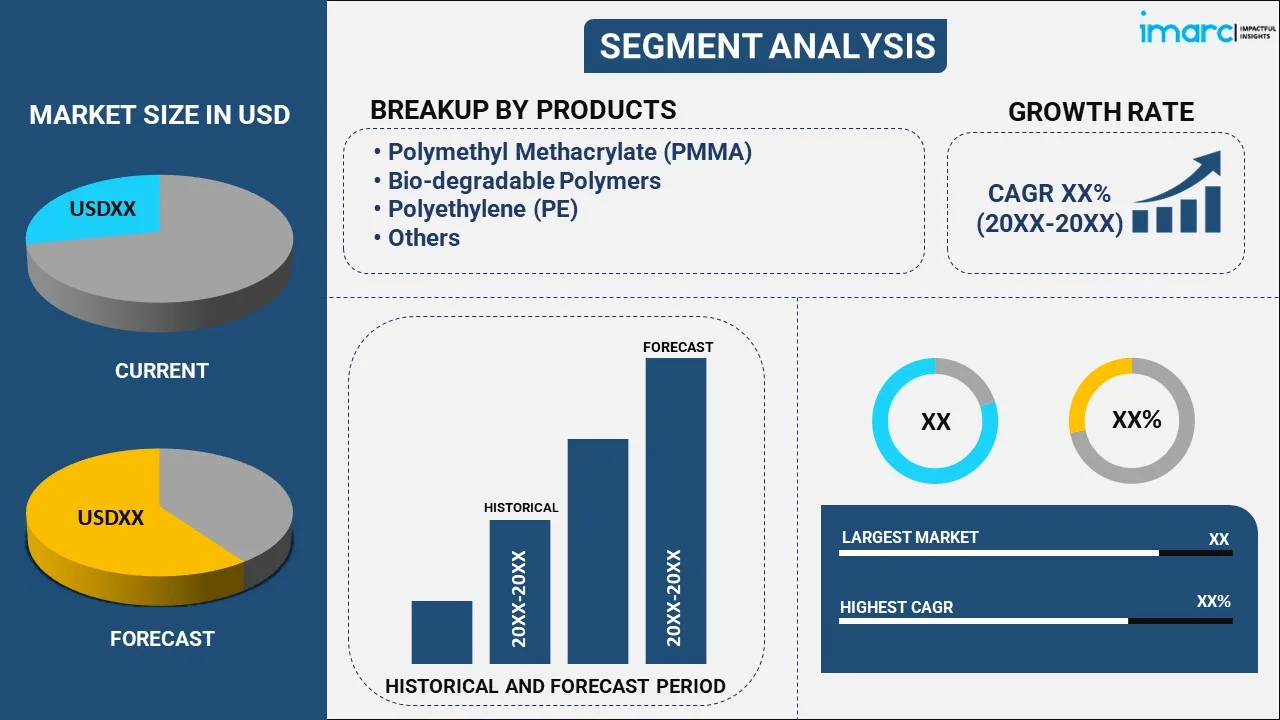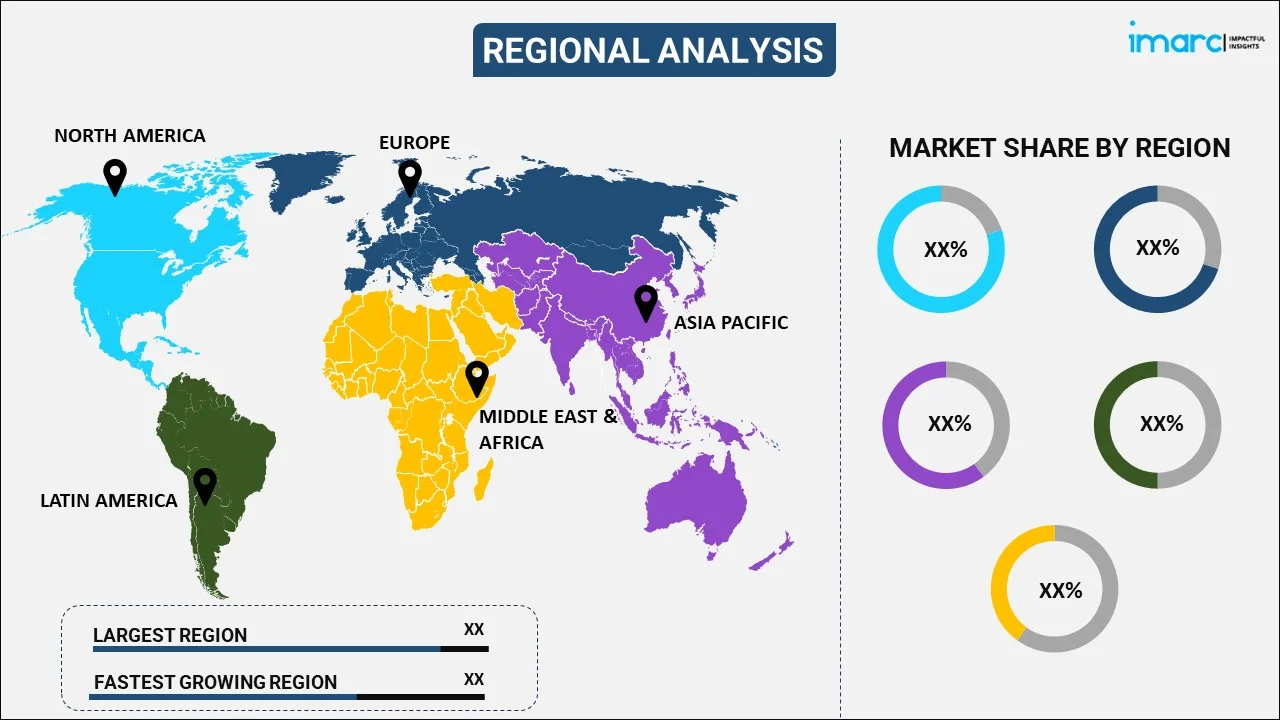
Thermoformed Plastics Market Report by Product (Polymethyl Methacrylate (PMMA), Bio-degradable Polymers, Polyethylene (PE), Acrylonitrile Butadiene Styrene (ABS), Poly Vinyl Chloride (PVC), High Impact Polystyrene (HIPS), Polystyrene (PS), Polypropylene (PP)), Process (Plug Assist Forming, Thick Gauge Thermoforming, Thin Gauge Thermoforming, Vacuum Snapback), Application (Healthcare and Medical, Food Packaging, Electrical and Electronics, Automotive Packaging, Construction, Consumer Goods and Appliances, and Others), and Region 2025-2033
Market Overview:
The global thermoformed plastics market size reached USD 46.3 Billion in 2024. Looking forward, IMARC Group expects the market to reach USD 69.4 Billion by 2033, exhibiting a growth rate (CAGR) of 4.37% during 2025-2033. The rising demand from packaging manufacturers because of its lightweight and cost-effectiveness, increasing product use in several applications and the introduction of automated thermoforming machines are supporting the market growth.
|
Report Attribute
|
Key Statistics
|
|---|---|
|
Base Year
|
2024
|
|
Forecast Years
|
2025-2033
|
|
Historical Years
|
2019-2024
|
|
Market Size in 2024
|
USD 46.3 Billion |
|
Market Forecast in 2033
|
USD 69.4 Billion |
| Market Growth Rate 2025-2033 | 4.37% |
Thermoformed plastics are made and processed using the thermoforming process. These plastics are produced by heating sheets of acrylics, bio-degradable polymers, polycarbonates, acrylonitrile butadiene styrene (ABS) and polyvinyl chloride (PVC) which are further shaped and trimmed for obtaining a desired shape. They offer better aesthetic and design flexibility, convenience for manufacturing large-sized components, optimal utilization of the raw materials and low manufacturing costs. Owing to this, thermoformed plastics are used to produce automotive dashboards, seats, interior panels, air ducts and bumpers, light fixtures and electrical panels.

Thermoformed Plastics Market Trends:
Escalating demand from emerging from packaging industry
As people are gravitating towards ready-to-eat (RTE) meals, frozen foods, and other convenience items, thermoformed plastics are increasingly employed for packaging. Their lightweight, sturdy, and cost-effective option for trays, clamshells, and containers make them excellent for food packaging. Thermoformed polymers, particularly PET and PVC, are chosen in food packaging because of their barrier qualities, which aid in freshness preservation, contamination risk reduction, and product shelf-life extension. The capacity to generate unique shapes and sizes to fulfil specific product needs is driving demand for thermoformed plastics.
Cost-effectiveness
When compared to methods, such as injection molding, thermoforming requires a substantially smaller initial tooling expenditure. The molds used in thermoforming are simpler and less expensive to make, making it a more cost-effective option for producers, particularly for small to medium production runs. This saves capital expenditures and enables businesses to be more agile in product development. For businesses wishing to develop prototypes or limited production runs, thermoforming is a far more cost-effective choice. The low-cost tooling makes it easy to manufacture prototypes without incurring the significant expenses associated with other approaches, allowing for shorter product development cycles. Thermoforming has faster production cycles than other technologies like blow molding or injection molding. This means that producers may make a huge volume of plastic components or packaging in a shorter period, lowering labor costs and enhancing operational efficiency.
Technological advancements
The introduction of automated thermoforming machines with superior control systems is substantially increasing the speed, accuracy, and consistency of the thermoforming process. These machines have features like as real-time monitoring, automatic material feeding, and accurate temperature control, which reduces human mistake and ensures constant product quality. Newer machines have faster cycle times, allowing producers to create larger amounts of thermoformed plastic in less time. This improvement in productivity helps to meet rising market demand in areas, such as packaging, automotive, and healthcare. Technological advancements in polymer science are resulting in the creation of high-performance thermoplastic polymers with exceptional qualities. These materials have better barrier qualities, greater strength, longer durability, and better resistance to chemicals and heat. For example, the emergence of biodegradable and recyclable materials, such as polylactic acid (PLA) and recycled PET (rPET) is driving the demand for eco-friendly thermoformed products.
Key Market Segmentation:
IMARC Group provides thermoformed plastics market analysis of the key trends in each segment of the market report, along with forecasts at the global, regional and country levelsw from 2025-2033. Our report has categorized the market based on product, process and application.
Breakup by Product:

- Polymethyl Methacrylate (PMMA)
- Bio-degradable Polymers
- Polyethylene (PE)
- Acrylonitrile Butadiene Styrene (ABS)
- Poly Vinyl Chloride (PVC)
- High Impact Polystyrene (HIPS)
- Polystyrene (PS)
- Polypropylene (PP)
Breakup by Process:
- Plug Assist Forming
- Thick Gauge Thermoforming
- Thin Gauge Thermoforming
- Vacuum Snapback
Breakup by Application:
- Healthcare and Medical
- Food Packaging
- Electrical and Electronics
- Automotive Packaging
- Construction
- Consumer Goods and Appliances
- Others
Breakup by Region:

- North America
- United States
- Canada
- Asia-Pacific
- China
- Japan
- India
- South Korea
- Australia
- Indonesia
- Others
- Europe
- Germany
- France
- United Kingdom
- Italy
- Spain
- Russia
- Others
- Latin America
- Brazil
- Mexico
- Others
- Middle East and Africa
Competitive Landscape:
The report has also provided a comprehensive analysis of the competitive landscape in the global thermoformed plastics market. Competitive analysis such as market structure, thermoformed plastics market share by key players, player positioning, top winning strategies, competitive dashboard, and company evaluation quadrant has been covered in the report. Also, detailed profiles of all major companies have been provided. Some of the companies covered include:
- Amcor plc
- Anchor Packaging LLC
- Berry Global Inc
- Brentwood Industries Inc.
- D&W Fine Pack
- Dart Container Corporation
- Fabri-Kal Corp. (Two Mitts Inc.)
- Genpak LLC (C-P Flexible Packaging)
- Greiner Packaging GmbH
- Pactiv LLC
- Placon Corporation
- Sabert Corporation
- Sonoco Products Company
Kindly note that this only represents a partial list of companies, and the complete list has been provided in the report.
Thermoformed Plastics Market News:
- April 2024: Nefab Group, through Nefab Packaging, Inc. USA, acquired Plastiform, Inc. and its subsidiary Precision Formed Plastics, Inc., a Texas based group specializing in high quality thermoformed cushioning solutions, made from recycled plastics, to further strengthen its global market position and commitment to saving resources in supply chains.
- February 2024: Amcor announced that it is expanding its North American thermoforming capabilities for the healthcare market with the addition of automated, state-of-the art thermoforming equipment at its healthcare manufacturing plant in Oshkosh, WI, will support increasing demand from customers in the medical, pharmaceutical, and consumer health sectors.
Report Coverage:
| Report Features | Details |
|---|---|
| Base Year of the Analysis | 2024 |
| Historical Period | 2019-2024 |
| Forecast Period | 2025-2033 |
| Units | Billion USD |
| Segment Coverage | Product, Process, Application, Region |
| Region Covered | Asia Pacific, Europe, North America, Latin America, Middle East and Africa |
| Countries Covered | United States, Canada, Germany, France, United Kingdom, Italy, Spain, Russia, China, Japan, India, South Korea, Australia, Indonesia, Brazil, Mexico |
| Companies Covered | Amcor plc, Anchor Packaging LLC, Berry Global Inc, Brentwood Industries Inc., D&W Fine Pack, Dart Container Corporation, Fabri-Kal Corp. (Two Mitts Inc.), Genpak LLC (C-P Flexible Packaging), Greiner Packaging GmbH, Pactiv LLC, Placon Corporation, Sabert Corporation and Sonoco Products Company |
| Customization Scope | 10% Free Customization |
| Post-Sale Analyst Support | 10-12 Weeks |
| Delivery Format | PDF and Excel through Email (We can also provide the editable version of the report in PPT/Word format on special request) |
Key Questions Answered in This Report
The global thermoformed plastics market was valued at USD 46.3 Billion in 2024.
We expect the global thermoformed plastics market to exhibit a CAGR of 4.37% during 2025-2033.
The rising requirement for effective packaging solutions, along with the increasing demand for thermoformed plastics to seal food products, as they provide barrier properties against bacteria, odor, and moisture particles, is primarily driving the global thermoformed plastics market.
The sudden outbreak of the COVID-19 pandemic had led to the implementation of stringent lockdown regulations across several nations, resulting in the temporary halt in numerous production activities for thermoformed plastics.
Based on the product, the global thermoformed plastics market can be divided into Polymethyl Methacrylate (PMMA), bio-degradable polymers, Polyethylene (PE), Acrylonitrile Butadiene Styrene (ABS), Poly Vinyl Chloride (PVC), High Impact Polystyrene (HIPS), Polystyrene (PS), and Polypropylene (PP). Currently, Polypropylene (PP) exhibits a clear dominance in the market.
Based on the process, the global thermoformed plastics market has been categorized into plug assist forming, thick gauge thermoforming, thin gauge thermoforming, and vacuum snapback. Among these, thin gauge thermoforming currently accounts for the majority of the global market share.
Based on the application, the global thermoformed plastics market can be segregated into healthcare and medical, food packaging, electrical and electronics, automotive packaging, construction, consumer goods and appliances, and others. Currently, food packaging holds the largest market share.
On a regional level, the market has been classified into North America, Asia-Pacific, Europe, Latin America, and Middle East and Africa, where North America currently dominates the global market.
Some of the major players in the global thermoformed plastics market include Amcor plc, Anchor Packaging LLC, Berry Global Inc, Brentwood Industries Inc., D&W Fine Pack, Dart Container Corporation, Fabri-Kal Corp. (Two Mitts Inc.), Genpak LLC (C-P Flexible Packaging), Greiner Packaging GmbH, Pactiv LLC, Placon Corporation, Sabert Corporation, and Sonoco Products Company.
Need more help?
- Speak to our experienced analysts for insights on the current market scenarios.
- Include additional segments and countries to customize the report as per your requirement.
- Gain an unparalleled competitive advantage in your domain by understanding how to utilize the report and positively impacting your operations and revenue.
- For further assistance, please connect with our analysts.
 Inquire Before Buying
Inquire Before Buying
 Speak to an Analyst
Speak to an Analyst
 Request Brochure
Request Brochure
 Request Customization
Request Customization




.webp)




.webp)












